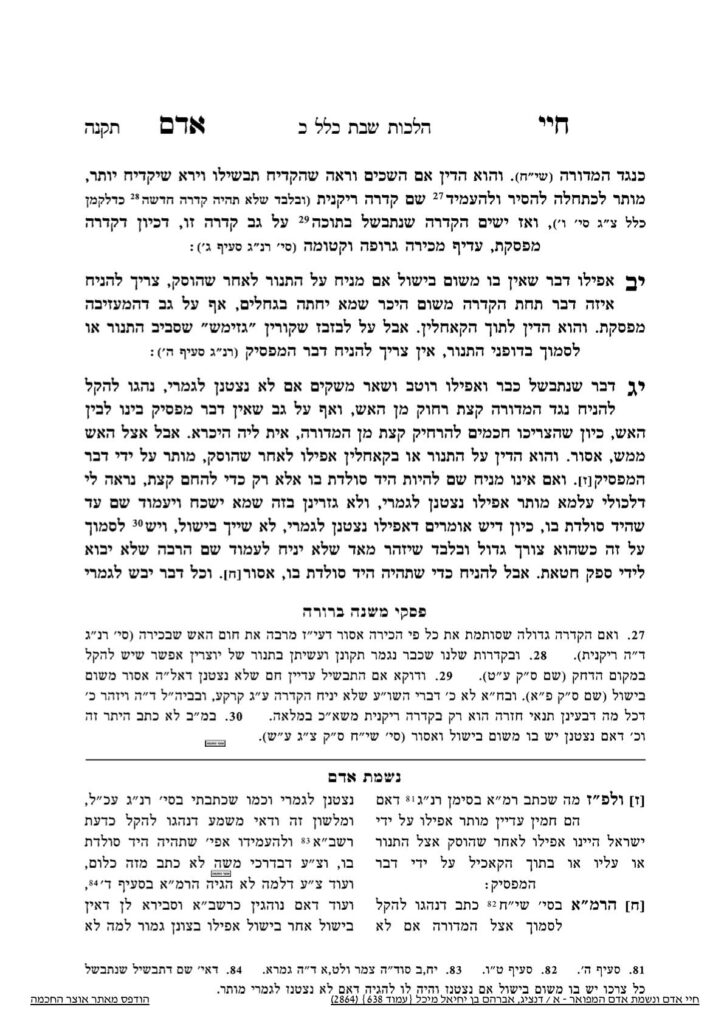We are beginning siman 12. The specific point of the Chayei Adam is not so familiar to us, because they had a different type of oven. His general point is that even in an oven where there is a separation between the fire and the place for the pot, it is still assur to place a pot there on Shabbos. Since that placement is the normal way to cook for that type of oven, there is no hekker for Shabbos. The separation does not fulfill any garuf or katum requirements. For example, if one pictures a potbelly stove, there was an opening in the middle for the wood, and a metal surface on top for cooking. Even though the food on the top has a barrier between it and the fire, since that is where one normally cooks, there is no hekker. One would still have to place a barrier between the top of the stove and the food.
The Chayei Adam adds that certain ovens had an additional ledge which was not used for cooking. If one placed the food on that ledge, it would be muttar, as the ledge serves as a hekker.
The question comes up regarding putting a food in a place where it will reach yad soledes bo, but it is not a normal place to cook, and there is no concern of bishul (either because it is a davar yaveish or because it is a davar lach which has not fully cooled down). Rav Moshe Feinstein writes about steam radiators, which would be heated with steam hotter than 212 degrees, and would heat the metal radiator and the entire room. Rav Moshe paskened that it is muttar to heat the above-mentioned foods on the steam radiator, and a hekker is not necessary, since it is not a normal place to cook.
Rav Moshe similarly discusses a steam table, which was similar to a sterno heating a tray of water, and the food tray is placed above that. It is different from a radiator in that it is used for heating food, but it is never used for cooking. Since it is never used for cooking, even nesinah lechatchilla is muttar. Again, this heter only applies to foods which do not have a concern of bishul, ie, a davar yaveish or a davar lach which is still warm.
The next question to discuss is a plata, which is also known as a hot plate. If it is not considered a normal place to cook, even nesinah lechatchillah will be muttar. If it functions as the equivalent of a covered fire, chazarah will be muttar, but nesinah lechatchillah will be assur. The poskim assume that if the plata does not get hot enough to cook on, it is the equivalent of the steam table discussed by Rav Moshe, and it would be muttar to perform nesinah lechatchillah, since it is not a place used for cooking.
However, Rav Moshe himself was asked about a hot plate, and answered that people do cook on them, so they can only be used for chazarah and not for nesinah lechatchillah. Many gedolei poskim in Eretz Yisrael permit nesinah lechatchillah on the plata on Shabbos, and it could be that the hot plates in Israel do not reach as hot of a temperature as ones in America. Rav Moshe’s view is, since if one is cooking and needs an extra burner, they would consider using their hot plate, even if they do not generally do so on a regular basis, it is considered a mokom bishul. Some have suggested that a lower temperature, “Israeli” version of the hot plate would be muttar to use in America. One should ask their rav.
Summary
- Regarding the hekker for chazarah, if the oven is constructed in a way that there is a natural separation between the fire and where the food is normally placed, it is not considered a hekker and something else must be done to establish garuf v’katum.
- A heat source which is not normally used for cooking can be used to heat up food, even for nesinah lechatchillah and even though it will reach yad soledes bo, provided there is no concern of bishul (ie, it is a davar yaveish or a davar lach which has not cooled down).
- Rav Moshe understood that a hot plate is a normal cooking surface, so nesinah lechatchillah is assur, and only chazarah will be muttar. Other poskim disagree, and although their machokes may be dependent on the heat of the hot plate, one should discuss with their local rav.



